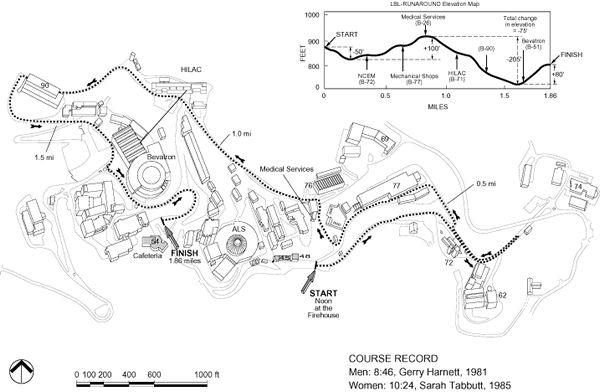
'Genius' Earth Scientist Can Now Pursue Volcanoes
A Year in Review: Progress and Promise
'Genius' Earth Scientist Can Now Pursue Volcanoes
Last month, on an otherwise typical Tuesday afternoon, Berkeley Lab geophysicist Michael Manga answered the phone and was told he will receive $500,000 over the next five years — no strings attached.
He was one of 25 people chosen to receive MacArthur Foundation “genius” awards, which the foundation awards each year to people selected for their “creativity, originality, and potential.” The awards were officially announced on Sept. 20.
“It was a complete surprise,” says Manga, a scientist in Berkeley Lab’s Earth Sciences Division and an associate professor of earth and planetary science at UC Berkeley. “The first thing that crossed my mind is that the award is two good proposals worth of money.”
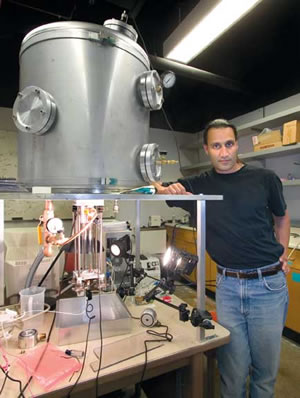
Michael Manga
Although the MacArthur Foundation keeps its selection process a closely guarded secret, it’s little wonder that Manga caught their eye. Since coming to Berkeley in 2001, Manga, 37, has made a name for himself developing innovative ways to study volcanoes, earthquakes, and tidal pressures on planets. A tank filled with two tons of corn syrup sits in his lab, which he uses to simulate the Earth’s mantle and crust. He also monitors the rise and fall of springs along the Hayward fault to learn how hydrological systems and earthquakes relate to each other. And he recently returned from Australia, where he studied desert springs that produce features similar to those found on Mars.
He plans to use the money to travel to volcanoes in Ethiopia and Tanzania, home to rare lava lakes that also appear on Jupiter’s moon Io. He’ll also pursue risky research that may not pan out, which makes for a tough sell to funding agencies.
“It’s difficult to receive funding to study the connections between earthquakes and water, because there’s a good chance I won’t learn anything unless there’s an earthquake,” says Manga. “I’d like to use the money to improve the instrumentation at springs in the Mission Peak region, near Fremont, CA.”
Manga has also recently turned to Berkeley Lab’s Advanced Light Source (ALS) to learn why some volcanoes erupt explosively, and why some don’t. He uses infrared spectromicroscopy to measure bubbles in chunks of obsidian found in lava flows. He also uses CT tomography to learn how bubbles in lava-formed rock connect to each other. These analyses, conducted at a resolution approaching two microns, help him understand the processes that drive eruptions, which allows him to improve computer models of how volcanoes work. This work could also receive a boost thanks to that recent unexpected phone call.
“I could use the MacArthur money as matching funds to build better equipment for three-dimensional CT scans,” says Manga.
Manga has good reason to feel like a kid in a candy store. The fellowship has no reporting requirements. He is free to use the money any way he chooses.
“The guy on the phone told me many times that I will never hear from them again,” says Manga
There was one rule, however. Manga received the good news seven days before the awards were announced. He was told he could only tell one person in the meantime, so he chose his wife, Bancroft Library archivist Susan Storch.
“I didn’t even tell my kids, but they are seven and two years old, so they wouldn’t have really understood anyway,” says Manga.
Manga joins six other Berkeley Lab MacArthur Fellows. Richard Muller received the award in 1982, followed by George Oster in 1985, Raymond Jeanloz in 1988, Mike Marletta in 1995, and Jill Banfield and Carolyn Bertozzi in 1999.
A Year in Review: Progress and Promise
Director Chu: My View
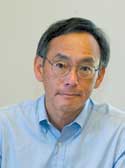
I arrived at Berkeley Lab just over a year ago, filled with admiration for the history and excitement about the future of this lab. Today, I am even more excited than I was that first day. As I look at what we have accomplished, and where we are headed, I can share many reasons for optimism, even in the face of challenging financial circumstances.
My vision for the future of Berkeley Lab was then, and remains now: a model facility for connectivity across divisions, a creative and nurturing environment that develops and grows new initiatives and the talented people who make them happen. We are getting there, thanks to a year of progress.
Of primary importance was the awarding of the new management contract to the University of California by the Department of Energy, a decision that insured, among other things, that our employees would retain their health and retirement benefits. An outstanding team of contributors from every part of the lab worked hard on the competition, and the result is the renewal of UC management without competition for up to 20 more years if we perform well.
UC’s victory also ensured that our valued partnerships with UC campuses – in particular, Berkeley, UC San Francisco, and UC Davis – would be preserved. One of my goals is to enhance these connections. For example, at Berkeley, we are working together to seek private donations for some of the buildings in our future plans. We would like to construct a hostel for the Lab’s scientific visitors, an energy/nanotechnology building, a computational sciences center, and an ALS user support building. I have also been working with the UC Office of the President to convince them that these buildings, to be built on the border of the Lab site and in conjunction with the Berkeley campus, are UC facilities that qualify to be paid for through the system’s bonding authority.
The energy/nano building would be central to one of our major scientific initiatives – the conversion of solar energy into carbon-neutral forms of energy that could sustain our world in an environmentally acceptable manner. This is one of the most important societal problems that science and technology can help solve, and Berkeley Lab, with its broad spectrum of expertise and its history of team collaborations, is ideally positioned to address this challenge.
We call the initiative “Helios,” after the Greek god of the sun. Associate Laboratory Director Paul Alivisatos and Physical Biosciences Director Jay Keasling are heading up the preparation of our proposal. Our research will cut across divisions and programs in profound ways to produce transforming technologies in synthetic biology and nanotechnology, and will fuse our core strengths in biological, chemical and physical sciences in the search for a sustainable, C02-neutral source of energy.
The energy problem isn’t the only thing I talk about when I visit Washington. We continue to push for the Joint Dark Energy Mission (JDEM) and our proposal for this mission, the SuperNova Acceleration Probe (SNAP). This DOE-NASA partnership holds great promise for discovering what mysterious force is driving the acceleration of the universe. My message also includes our NERSC supercomputer and computing sciences needs, the next-generation transformation of the Advanced Light Source (ALS), the Joint Genome Institute (JGI), and our proposed leadership in the DOE’s GTL initiative.
Our Lab initiatives also include continuing efforts in quantitative biology, including exciting collaborations with researchers at UC San Francisco (with National Cancer Institute support); in health diagnostics, genomic analysis and application, and in the nanotechnology promises of the Molecular Foundry, which will open with great anticipation in January. Our physical scientists continue to probe the origins of matter and energy by developing and utilizing tools that can study the infinitesimally small – both particles and processes. The ALS, a model user facility by any measure, will reinvent itself to remain effective and useful for many years to come, and the JGI is poised to become the international center for microbial sequencing.
These are just some of the reasons why I am excited about Berkeley Lab’s future. But we do have budgetary challenges. Projections for the federal 2006 budget and future years are for tightly constrained resources. Mandated programs from Washington, and the resulting costs to the lab, continue to increase. Our overhead collections, which are project assessments on which the Laboratory relies to maintain and support our facility, are down. Other costs continue to rise. Reductions-in-force and support program cuts have been among the unfortunate byproducts.
So I pledge to do my part to ensure that Berkeley Lab gets its fair share of federal science money. We will be working hard to seek new support from alternative funding options such as foundations. We will also strive to become more efficient with the resources we have.
Now I need a pledge from everyone at the Lab – put safety first. You’ve heard me talk about this continuously since my first day here. It’s on my mind. It’s on the Secretary of Energy’s mind. If we don’t develop a strong safety culture, our reputation and our contractual future are in jeopardy. In one year, we went from the science laboratory with the best safety record in the DOE, to one of the worst. It only takes a few accidents or near-misses. A major incident could shut us down indefinitely.
So I ask all of you to redouble your efforts to look out after yourselves and each other. With Berkeley Lab moving forward on so many great things, we owe it to ourselves to make this place the very best – and safest – that it can possibly be.National Panel Seek Urgent Federal Boost in Research, Education and Innovation
A federally commissioned blue-ribbon panel of experts that included Berkeley Lab’s Director, Steve Chu, released a dramatic new report this week on American prosperity in the 21st Century, and its implications will reverberate throughout Washington in the coming weeks. Sponsored jointly by the National Academies of Science, Engineering and Medicine, and requested by Congressional leadership, the report emphasizes the immediate importance of making new and creative investments in research, education and innovation before it’s too late.
“This nation must prepare with great urgency to preserve its strategic and economic security,” the report stated. “The committee is deeply concerned that the scientific and technical building blocks of our economic leadership are eroding at a time when many other nations are gathering strength.”
Chu was one of 20 on the committee, headed by retired Chairman and CEO of Lockheed Martin Corporation, Norman Augustine. Chu said it was “unlike any other National Academy study I have been on, in terms of the impressive and diverse make-up of its membership. NAS studies are usually dominated by academic scholars, while this committee was a roughly equal mixture of present and past CEO’s of major high-tech companies, top research university presidents, and accomplished scientists.”
In addition to Augustine, members included top executives of Intel (Craig Barrett), Dupont (Charles Holliday), Exxon Mobil (Lee Raymond), Merck & Co. (Roy Vagelos) and Eli Lilly (Gail Cassell); the Presidents of Texas A & M (Robert Gates), Rensselaer Polytechnic Institute (Shirley Jackson), Yale (Richard Levin), Maryland (Dan Mote) and MIT (Charles Vest); and scientists that included Nobelists Chu, Joshua Lederberg, and Robert Richardson.
What also made this effort unusual, Chu added, is that it was called for directly by Congress as a guide to help them formulate legislation. Senators Lamar Alexander and Jeff Bingaman made the request, supported by Congressmen Sherwood Boehlert and Bart Gordon.
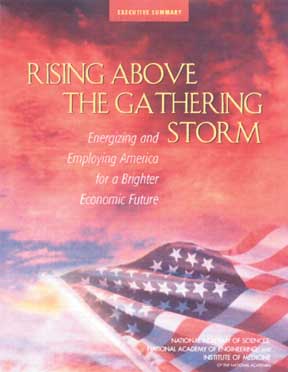
The group came up with four recommendations and 20 implementation actions designed as specific steps that can best strengthen the quality of life in America – “our prosperity, our health, and our security,” the report states. And underlying these actions are two overriding challenges that are tightly coupled to scientific and engineering prowess – creating high-quality jobs for Americans, and responding to the nation’s need for clean, affordable, and reliable energy.
“Our charge was to make recommendations on how America can prosper in the global economy of the 21st Century,” Chu said. “The basis of our economic competitiveness in this century will spring from our leadership in science and technology, and in our ability to create innovations from this leadership. There are clear indications that our world S&T leadership is threatened, and borrowing from Winston Churchill, we took as the title of the report ‘Rising Above the Gathering Storm’. The central theme in the report is the need to re-energize our scientific human capital, and the report draws particular attention to the physical sciences.”
He continued, “This view was widely supported, even by those members of the committee whose principal interest is in health care. The report points out in the introduction that many medical devices and procedures – such as endoscopic surgery, ‘smart’ pacemakers, kidney dialysis, and magnetic resonance imaging – are the result of R&D in the physical sciences, engineering, and mathematics.”
Entitled “Sowing the Seeds,” the recommendation section on research calls for sustaining and strengthening the nation’s traditional commitment to long-term basic research “that has the potential to be transformational to maintain the flow of new ideas that fuel the economy, provide security, and enhance the quality of life.” Its key implementation actions include:
- Increase the federal investment in long-term basic research by 10 percent a year over the next seven years. Special attention should be paid to the physical sciences, engineering, mathematics, and information sciences.
- Establish within the DOE an organization called the “Advanced Research Project Agency – Energy,” or ARPA-E. Reporting to the newly created Undersecretary for Science in the DOE, the ARPA-E agency – patterned after the Defense Advanced Research Projects Agency (DARPA) – would be charged with funding “out-of-the-box” energy research to meet the nation’s long-term energy challenges. The report suggests a $300 million program to start, increasing to $1 billion over five or six years.
- Provide new research grants of $500,000 each annually, payable over five years, to 200 of the most outstanding early-career scientists in the nation.
In three other areas besides research – K-12 education (“10,000 Teachers, 10 Million Minds”), higher education (“Best and Brightest”), and economic policy (“Incentives for Innovation”) – the panel made strong appeals for action.
To increase America’s talent pool, it recommended the creation of a merit-based scholarship program to attract 10,000 exceptional students to math and science teaching careers each year. Four-year scholarships, worth up to $20,000 annually, would be designated to help some of the nation’s top students obtain bachelor’s degrees in physical or life sciences, engineering, or math – with concurrent certification as K-12 math and science teachers. After graduation, they would be required to work for at least five years in public schools. Those who teach in disadvantaged inner-city or rural areas would receive a $10,000 annual bonus.
The study also supports strengthening 250,000 current teachers’ skills through training grants for participation in summer institutes, master’s programs, and advanced placement training programs.
To make the U.S. the most attractive setting in the world to study and conduct research, the committee urges policymakers to provide 25,000 new, competitive, four-year undergraduate scholarships and 5,000 new graduate fellowships to U.S citizens enrolled in physical science, life science, engineering and math programs.
“The report urges America to attract international students and scholars who will contribute to our research and innovation enterprise,” Chu noted. For foreign students, it recommends one-year automatic visa extensions if they have received doctorates or the equivalent in science, technology, engineering, math, or other fields of national need from U.S. institutions. If they succeed in getting job offers from employers here, they should automatically get work permits and expedited residency status. Doctoral level education, science and engineering skills would significantly raise an applicant’s chance of obtaining U.S. citizenship.
It also supports tax incentives for innovation based in the U.S. The Research and Experimentation tax credit available to companies that increase their R&D spending is due to expire in December; the panel said this credit should be made permanent and should raise allowable limits from 20 percent to 40 percent of qualifying R&D increases.
“The building blocks of our economic leadership are wearing away,” Committee Chairman Augustine said. “The challenges that America faces are immense.”
The report, subtitled “Energizing and Employing America for a Brighter Economic Future,” cited several “worrisome indicators” of why decisive action is needed now:
- For the cost of one chemist or one engineer in the United States, a company can hire about five chemists in China or 11 engineers in India.
- U.S. 12th-graders recently performed below the international average for 21 countries on a test of general knowledge in math and science.
- Less than one-third of United States 4th and 8th grade students are proficient in math.
- Last year, more than 600,000 engineers graduated from colleges and universities in China, 350,000 in India, and 70,000 in the United States.
“The United States must compete by optimizing its knowledge-based resources, particularly in science and technology, and by sustaining the most fertile environment for new and revitalized industries and the well-paying jobs they bring,” the report found.
The report can be found at the National Academies web site: http://national-academies.org.
Joshua Schrier, Newest Alvarez Fellow, Wants to Follow Namesake’s Flair for Invention
When Joshua Schrier thinks about how to explain his field of research to his parents, he knows that he won’t get far talking about self-consistent fields, wave functions and how the interaction of electrons at the organic-inorganic interface affect the properties in nanocrystals.
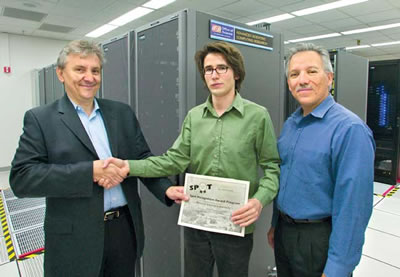
New Alvarez Fellow Joshua Schrier (center) is congratulated by CRD Director Horst Simon (left) and High Performance Computing Research Department Head Juan Meza.
So, he tells them he’s working on research that could lead to more efficient and less expensive solar cells. As a post-doc in the Computational Research Division’s Scientific Computing Group, Schrier is working with Lin-Wang Wang to develop new computational models to study the properties of nanoscale materials.
Schrier, who joined the Lab in May after earning his Ph.D. in chem-istry at UC Berkeley, has just been named as the fourth recipient of the Luis Alvarez Computational Science Fellowship. The award honors Nobel Laureate Alvarez, an LBNL physicist who was an early advocate of using computers to gather and analyze experimental data.
“It’s a great honor,” said Schrier. Not long after applying for the fellowship, he was browsing at Moe’s Books on Berkeley’s Telegraph Avenue when he came across a volume of papers by Alvarez, compiled by his fellow researchers. “What was amazing to me was the scope of things he was interested in during his life – from the extinction of dinosaurs to secret chambers in the pyramids to beta decay to the bubble chamber — he did well in many fields, making solid contributions.”
Schrier was also impressed by Alvarez’ flair for invention. After going on a photo safari in Africa and being bothered by a jittery camera, Alvarez invented a self-stabilizing camera to get clearer shots. “He was always inventing new ways to study problems,” Schrier said.
And in the emerging field of nanotechnology, Wang and Schrier are also coming up with new methods for studying problems involving the behavior of electrons, which determine a material’s properties. These properties can be used for different purposes, such as processing information. One method of tapping into these properties has been to move the electrons, as is done in transistors. But now scientists are looking into a new idea of controlling the spin of electrons, rather than moving them, to process and store information. If successful, such systems would require less power and would be more robust.
SHARES Campaign Kicks Off
What do music classes in the City of Berkeley’s elementary schools, $1.1 million to help build Rosa Parks Elementary School, and hundreds of grants to local teachers have in common? They’re all the result of the Berkeley Public Education Foundation, an organization dedicated to improving Berkeley’s public schools. And they’re all made possible by donations.
“Most of our money comes from individual donations, and an increasing and important percentage of donations comes from workplace giving programs,” says Trina Ostrander, executive director of the Berkeley Public Education Found-ation. “We appreciate Berkeley Lab’s contributions. Even a small gift helps a lot. Less than $100 allowed a teacher to get a subscription to a science magazine for a third grade class.”

Beginning Oct. 14 and through Nov. 18, Berkeley Lab employees will have the opportunity to donate to the Berkeley Public Education Foundation or any agency designated as a tax-exempt IRS 501(c)(3) through a program called SHARES, for Science for Health, Assistance, Resources, Education and Services. The campaign, now entering its eighth year, supports Berkeley Lab’s commitment to reach out to surrounding communities and help organizations that depend largely on donations.
Berkeley Lab employees have received a packet in the mail that outlines the donation process and lists 18 local charities dedicated to science and education outreach, as well as energy conservation.
In addition to Berkeley Lab SHARES, options may be found among the following organizations: Community Health Charities of California, United Way of the Bay Area, Earth Share of California, and the Bay Area Black United Fund.
Donors can also commit contributions through a web-based format created by Community Health Charities. This secure and user-friendly website, accessed at http://www.lbl.gov/shares/, allows employees to select charities, choose a method of payment — payroll deduction, check or credit card — and disburse funds among the charities. The online donation form works best in Internet Explorer, although other browsers can be used.
Employees who have a favorite charity that is not included in the list can still donate through the donor choice write-in option on the donor form. All donations are tax deductible. One-time gifts by check will be applied to year 2005 tax returns, while the payroll deduction option will take effect on Jan. 1 and will apply to tax year 2006. Employees with questions can e-mail SHARES@lbl.gov.

![]()

![]()
![]()
Contributions given to Community Health Charities of California, Berkeley Lab SHARES, and any write-in charity are subject to an 11 percent administrative fee. Contributions given to the Bay Area Black United Fund, United Way of the Bay Area, and Earth Share of California are subject to 14 percent, 15 percent, and 11.2 percent administrative fees, respectively.
According to Nan Steketee, a representative from Earth Share of California, such administrative fees make sense because workplace giving campaigns such as SHARES give organizations the ability to reach a wider audience than they can on their own. In addition, payroll deduction gifts are between three and seven times larger than one-time gifts, so even if the administrative fee is deducted, the final amount received is more. And the federations combine the contributions from many workplaces into one quarterly check. Processing one check for thousands of contributions rather than thousands of checks from individual donors represents a big cost savings.
“If you were to send your check to the organization, 100% of it would get there, but the organization would spend more money processing your check and advertising for your gift than they do by paying the fee and receiving your gift through the SHARES campaign,” says Steketee.
Golden Anniversary for Discovery of the Antiproton at Bevatron
The paper entitled, Observation of Antiprotons, by Owen Chamberlain, Emilio Segrè, Clyde Wiegand and Tom Ypsilantis, from what was then known as the Radiation Laboratory of UC Berkeley, was published in the November 1, 1955 issue of Physical Review Letters. It announced the discovery of a new sub-atomic particle, identical in every way to the proton except that it’s electrical charge was negative instead of positive.
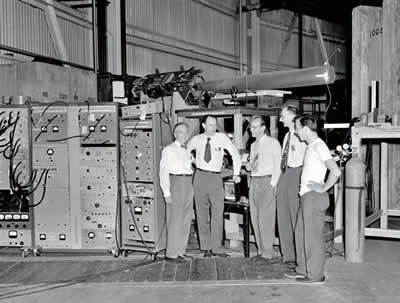 The antiproton discovery team included, from the left, Emilio Segrč, Clyde Wiegand, Edward Lofgren, Owen Chamberlain and Thomas Ypsilantis.
The antiproton discovery team included, from the left, Emilio Segrč, Clyde Wiegand, Edward Lofgren, Owen Chamberlain and Thomas Ypsilantis.
The discovery of the antiproton was greeted with great celebration in the scientific community and would win for Chamberlain and Segrè the 1959 Nobel Prize in physics. In the popular press, however, it received mixed reviews. Whereas the New York Times enthusiastically proclaimed: “New Atom Particle Found; Termed a Negative Proton,” the particle’s hometown newspaper, the Berkeley Gazette, somberly announced: “Grim new find at UC.”
Apparently, the Gazette reporter had been told that should any of the new antiprotons come in contact with a person, that person would blow up. Today, 50 years later, anti-protons have become a staple of high-energy physics experiments, with trillions being produced at CERN and Fermilab, and no known human fatalities.
History is filled with stories about serendipitous scientific discoveries, but the antiproton is not one of those. Its discovery was the culmination of a hunt whose origins can be traced back to 1928, when British physicist Paul Dirac formulated a theory to describe the behavior of relativistic electrons in electric and magnetic fields that allowed for particles of negative energy.
Few physicists gave Dirac’s idea much serious consideration until 1932, when Cal Tech physicist, Carl David Anderson, reported the observation of a negatively charged electron, which he dubbed the “positron.” The discovery of the positron ignited the imaginations of scientists and science fiction writers everywhere, for its existence made feasible antimatter — a world of positive electrons and negative protons, the mirror image of our own. All that was needed was an antiproton.
Anderson discovered the posi-tron by probing cosmic rays with a cloud chamber, but it was extremely difficult if not impossible to use the same approach for finding the antiproton. If physicists were going to find the antiproton, they were first going to have to make one.
It would be another two decades before a machine capable of producing such a particle would become available.
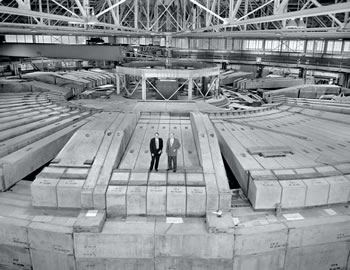 Berkeley physicists Edwin McMillan and Edward Lofgren shown on the shielding of the Bevatron, were part of the team assembled by Ernest Lawrence to ensure that the new synchrotron would be able to reach the 6.5 BeV needed to produce an antiproton.
Berkeley physicists Edwin McMillan and Edward Lofgren shown on the shielding of the Bevatron, were part of the team assembled by Ernest Lawrence to ensure that the new synchrotron would be able to reach the 6.5 BeV needed to produce an antiproton.
As Chamberlain noted in his Nobel laureate lecture, when they made plans for the Rad Lab’s next big accelerator, Ernest Lawrence and Edwin McMillan were well aware that to produce an antiproton, given the fixed target technology of the times, a beam of protons would have to be accelerated to 6 billion electron volts of energy. They made certain that their new accelerator, a synchrotron that would be named “Bevatron,” would surpass that threshold.
The Bevatron was commissioned in 1954 as a weak-focusing proton synchrotron, designed to accelerate protons up to energies of 6.5 billion electron volts, then designated as BeV (now universally known as GeV). Armed with a machine that had the energetic muscle to make antiprotons, Lawrence and McMillan put together two teams to go after the elusive particle. One team was led by Edward Lofgren, who managed operations of the Bevatron. The other was led by Segrè and Chamberlain.
Of course, making an antiproton was only half the challenge. No less formidable a task was devising a means of identifying the beast once it had been spawned. For every antiproton created, 40,000 other particles would also come into existence. The time to cull the antiproton out from the surrounding herd would be brief: within about a 10 millionth of a second after it appears, an antiproton comes into contact with a proton and both particles are annihilated.
Needing two independent quantities to identify a particle as an antiproton, the Segrè and Chamberlain team elected to measure momentum and velocity. To measure momentum, they used a system of magnetic quadrupole lenses set up so that negative particles of a defined momentum would be deflected into collimator apertures.
To measure velocity, which was used to separate antiprotons from negative pions, the team deployed a combination of scintillation time-of-flight counters, and a pair of Cerenkov detectors, one of which would only be set off by particles moving at the speed predicted for antiprotons.
In conjunction with those experiments, a related experiment using photographic emulsion stacks was conducted under the leadership of Berkeley physicist Gerson Goldhaber and Edoardo Amaldi from Rome. If a suspect particle was truly an antiproton, scientists expected to see the signature star image of an annihilation event, in which the antiproton and a proton or neutron from an ordinary nucleus, presumably that of a silver or bromine atom in the photographic emulsion, died simultaneously.
The antiproton experiments of the Segrè and Chamberlain team began the first week of August in 1955. Their first run on the Bevatron lasted five consecutive days. Lofgren and his collaborators ran their experi-ments the following two weeks. The Segrè and Chamberlain group returned on August 29 and ran until the Bevatron broke down on September 5. On September 21st, a week after operating crews had revived the Bevatron, the future Nobel laureates and their team got their first evidence of the antiproton based on momentum and velocity. Subsequent analysis of the emulsion stack images revealed the signature annihilation star that confirmed a discovery that was as golden then as it is today.
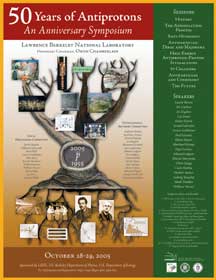
Lab to Host Antiproton Symposium October 28-29
As part of the “World Year of Physics 2005,” the Berkeley Lab Physics Division is commemorating the 50-year anniversary of the discovery of the antiproton with a special “50 Years of Antiprotons" Symposium. The event will take place in the Building 50 Auditorium, October 28-29. The two-day symposium will feature distinguished physicists from around the world speaking on the history of the antiproton discovery, the annihilation process and other antimatter, high-energy antiproton-proton interactions, antiparticles and cosmology, and thoughts about future experiments and theories. Speakers will include a few of the physicists who were involved with the original discovery. For more information about the program, including a full list of speakers and topics, historical photos and on-line registration, visit http://inpa.lbl.gov/pbar/pbar.htm.
DNA Chip Scans for Disease-Causing Microbes Technology Could Help hurricane-Ravaged Areas
New Orleans may be drying out, but the floodwaters that filled the city’s streets in the aftermaths of Hurricanes Katrina and Rita left behind bacteria that will pose a health risk to residents for many months to come. An experimental technology, called a “Phylochip,” developed by Berkeley Lab scientists could be used to provide authorities with a comprehensive picture of bacterial presence in the air, soil and the water, and enable them to track how that presence changes over time.
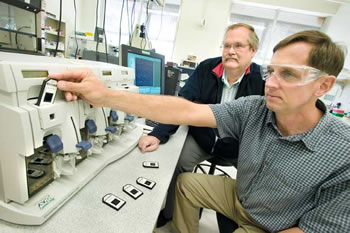 Terry Hazen (left) and Gary Andersen, microbiologists with Berkeley Lab, are shown here with the 16s Phylochip they developed that can analyze a sample for the unique DNA signatures of all known species of bacteria.
Terry Hazen (left) and Gary Andersen, microbiologists with Berkeley Lab, are shown here with the 16s Phylochip they developed that can analyze a sample for the unique DNA signatures of all known species of bacteria.
“Warm and stagnant bodies of water frequently give rise to large numbers of different bacterial pathogens and opportunistic organisms,” said Terry Hazen, a microbiologist with the Earth Sciences Division (ESD), and a leading authority on pathogens in warm environments. “A key challenge is a comprehensive identification of all potentially deleterious organisms without prior knowledge of the diversity of pathogens that may be present.”
Using a square-shaped DNA chip, the size of a quarter and packed with an array of 500,000 probes, Hazen and his colleagues can analyze a sample for the unique DNA signatures of 9,000 known species in the Phyla of bacteria and Archaea. The analysis can be completed within 24 hours from the start of the process.
“Our Phylochip makes its identification based on variations in the 16S rRNA gene, which is essential for protein synthesis and is present in all bacteria,” said ESD microbiologist Gary Andersen. “Small regions of DNA base-pair sequence differences within the 16S rRNA gene can be used to distinguish different bacterial species, including pathogens. The advantage of this approach is that multiple pathogens can be identified simultaneously by targeting unique regions of the 16S rRNA gene sequence in the samples.”
The bacterial problems facing the coastal areas of Louisiana, Mississippi and Alabama, which were ravaged by Hurricane Katrina, and areas in Texas and Louisiana impacted by Hurricane Rita, are likely to persist for an extended period of time, according to Hazen. As flooded areas dry out, some of the pathogens in the contaminated water will become airborne. Others will be absorbed or adsorbed into the soil. Some of these will percolate down into the groundwater, and others will remain near the soil surface where they could be desorbed through precipitation.
“Every time it rains, we could be seeing a spike in bacterial pathogen activity,” said Hazen. “The microbial population currently in that flood environment is complex and dynamic.”
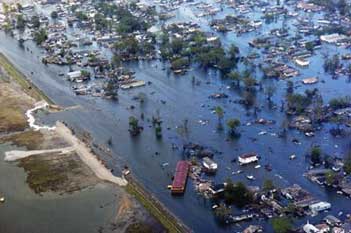 The floods that filled the streets of New Orleans and elsewhere in the aftermath of Hurricanes Katrina and Rita pose long-term health risks to residents, even after the waters have been cleared. (Photo by Kathy Anderson, LOLA)
The floods that filled the streets of New Orleans and elsewhere in the aftermath of Hurricanes Katrina and Rita pose long-term health risks to residents, even after the waters have been cleared. (Photo by Kathy Anderson, LOLA)
With the Phylochip and special software developed at Berkeley Lab, health and environmental officials monitoring the areas flooded by Katrina and Rita could be provided with what Hazen characterizes as “snapshots” over a period of time. These snapshots would tell officials whether specific populations of bacterial organisms are increasing or decreasing. Samples collected from critical locations would have to be transported to Berkeley Lab for DNA extraction, polymerase chain reaction (PCR) amplification, and array hybridization on the Phylochip.
The key to the Phylochip’s success is the 16S rRNA gene, which codes for a small substructure of the organelle in biological cells known as a ribosome. For bacteria, the DNA sequences that make up the 16s rRNA gene have been highly conserved throughout evolution, and can be used to positively identify individual species within the Phyla. These DNA sequences can also be used to infer natural relationships between different species.
In addition to bacterial pathogens, the 16s Phylochip would also reveal the presence in samples of bacterial species that are capable of degrading or transforming contaminants of concern. Under the right conditions, bioremediation and natural attenuation can be the safest and most cost-effective environmental remediation technique.
“We can validate the possibility of natural biodegradation and determine which species of biodegraders should be stimulated,” said Hazen. “With this information, appropriate treatability studies can be designed for determining the best and most cost-effective remediation strategy.”
RESEARCH ROUNDUP: LATEST NEWS FROM THE LAB
Supernova Explosion May Have Caused Mammoth Extinction
A distant supernova that exploded 41,000 years ago may have led to the extinction of the mammoth, according to research conducted by Berkeley Lab nuclear scientist Richard Firestone.
 .
.
Firestone, who collaborated with Arizona geologist Allen West on this study, unveiled this theory last month at the 2nd international conference of “The World of Elephants” in Hot Springs, SD. Their theory joins the list of possible culprits responsible for the demise of mammoths, which last roamed North America roughly 13,000 years ago. Scientists have long eyed climate change, disease, or intensive hunting by humans as likely suspects.
Firestone and West believe that debris from a supernova explosion coalesced into low-density, comet-like objects that wreaked havoc on the solar system long ago. One such comet may have hit North America 13,000 years ago, unleashing a cataclysmic event that killed off the vast majority of mammoths and many other large North American mammals. They found evidence of this impact layer at several archaeological sites throughout North America where Clovis hunting artifacts and human-butchered mammoths have been unearthed. It has long been established that human activity ceased at these sites about 13,000 years ago, which is roughly the same time that mammoths disappeared.
More Intense Heat Waves Could Slam California’s Energy Grid

Climate change and rolling blackouts may be a package deal. More frequent and intense heat waves expected in California over the next 100 years could overburden the state’s electric utility grid, according to a study led by Berkeley Lab scientists.
“If a large area of California is hot and there is also demand on the energy grid throughout the western U.S., these conditions will likely lead to blackouts,” says Norm Miller, a Berkeley Lab climatologist who examined the impacts heat extremes will have on the Golden State’s energy demands.
In the energy demand analysis — which was also conducted by Jiming Jin and Alan Sanstad of Berkeley Lab, Katharine Hayhoe of AtmosResearch Consulting, and Maxmilian Auffhammer of UC Berkeley — Miller’s team analyzed several greenhouse gas emission scenarios adopted by the Intergovernmental Panel on Climate Change, a United Nations-formed organization that informs the world’s policymakers on climate change and impacts.
They coupled these emission scenarios with observed heat wave trends in California, and determined that the onset of heat waves will come earlier each summer, and there will be more and longer lasting heat waves during future summers.
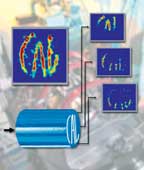 In a demonstration of remote NMR detection, the letters CAL, carved through the end of a plastic tube placed in an NMR encoding coil, were reconstructed from 10 batches of spin-polarized xenon carried to a detection coil at a separate location. Although the batches arrived at different times, the spatial arrangement of the letters was accurately reproduced.
In a demonstration of remote NMR detection, the letters CAL, carved through the end of a plastic tube placed in an NMR encoding coil, were reconstructed from 10 batches of spin-polarized xenon carried to a detection coil at a separate location. Although the batches arrived at different times, the spatial arrangement of the letters was accurately reproduced.
NMR Technology Comes to the Lab on a Chip
A team of scientists with Berkeley Lab and UC Berkeley has demonstrated a means by which nuclear magnetic resonance (NMR), one of the most powerful analytic tools known to science, can be made compatible with microfluidic “lab-on-a-chip” devices. This demonstration holds great promise for biomedical research, the detection of biohazards and toxic chemicals, and other endeavors in which the chemical composition of super-tiny amounts of fluids must be determined.
“Our novel methodology bypasses the long-standing problem of optimizing the two basic steps of NMR, signal encoding and detection, by physically separating them, and, at the same time, adds an important dimension to the study of fluid flow dynamics with the possibility of time-of-flight measurements,” said Alexander Pines, one of the world’s leading authorities on NMR technology. Pines holds a joint appointment as a chemist with Berkeley Lab’s Materials Sciences Division and with UC Berkeley, where he is the Glenn T. Seaborg Professor of Chemistry.
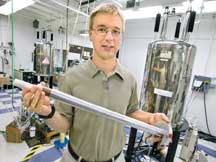 Christian Hilty is a member of the Alexander Pines research group and principal author of paper in which it was demonstrated that NMR spectroscopy can be used with microfluidic “lab-on-a-chip” devices.
Christian Hilty is a member of the Alexander Pines research group and principal author of paper in which it was demonstrated that NMR spectroscopy can be used with microfluidic “lab-on-a-chip” devices.
The technique in which NMR signal encoding and detection are carried out independently (in a conventional NMR setup, the two actions take place within a single device) is called remote NMR detection. In a paper published in the October 7, 2005 edition of the Proceedings of the National Academy of Sciences (PNAS), Pines and his collaborators describe the use of remote NMR to study the flow of gases through microfluidic devices.
“Remote detection of the NMR signal overcomes the sensitivity limitation of NMR and enables spatially resolved imaging in addition to time-of-flight measurements,” said chemist Christian Hilty, a member of Pines’ research group and the principal author of the PNAS paper. “Our approach also offers the unique advantage of being non-invasive. We can use it to measure microfluidic flow without the introduction of foreign tracer particles. This is important for the design and the operation of microfluidic devices.”
Co-authoring the PNAS paper with Hilty and Pines were Erin McDonnell, Josef Granwehr, Kimberly Pierce and Song-I Han, all of whom at the time of the study held joint appointments with Berkeley Lab and UC Berkeley. The work is supported by the U.S. Department of Energy’s Basic Energy Sciences program in the Office of Science.
People, Awards, and Honors
Bissell and Hazen honored as BER Distinguished Scientists
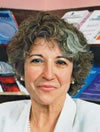
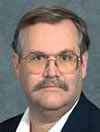
Mina Bissell (left), Terry Hazen
Berkeley Lab’s Mina Bissell and Terry Hazen have each won Office of Biological and Environmental Research (BER) Distinguished Scientist Fellowship awards. This is the first year of the awards, which went to a scientist representing each of BER’s four divisions. Bissell won in BER’s Life Sciences Division for her pioneering work with breast cancer and the extracellular matrix. Hazen won in BER’s Environmental Remediation Sciences Division for his work on the bioremediation of solvents and metals. Bissell and Hazen will each receive $250,000 per year for up to five years, so long as they remain with Berkeley Lab.
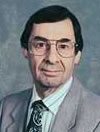 Elton Cairns
Elton Cairns
Electrochemist Cairns Joins Honorary Society
Elton Cairns, with the Lab’s Environmental Energy Technologies Division, has been inducted as an honorary member to the International Society of Electrochemistry. Cairns and his research group study the “fundamental properties and behavior of electrodes employed in high-performance rechargeable batteries and fuel cells.” He is the former director of what was then called the Energy and Environment Division.
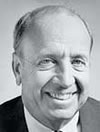 Thomas Budinger
Thomas Budinger
Life Scientist President Of Imaging Society
Berkeley Lab life scientist Thomas Budinger, who heads the Nuclear Medicine and Functional Imaging group, has been elected as president of the Society of Molecular Imaging. The international scientific and educational organization seeks to advance understanding of biology and medicine through noninvasive in vivo investigation of cellular molecular events involved in normal and pathologic processes. Budinger’s group explores advanced positron emission tomography and nuclear magnetic resonance techniques, which are used to study cardiac function and brain disorders such as Alzheimer’s and Parkinson’s disease.
In Memoriam
Cindy Polansky
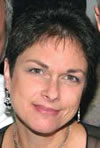 Cindy Polansky
Cindy Polansky
Cindy Polansky, who began work at the Lab in 1979 for what was then called the Energy and Environment Division, passed away on Sunday, Sept. 14. Polansky worked in the Division’s California Institute for Energy & Environment unit as an administrator. In 2000, the unit became a part of the University of California Office of the President, although Polansky retained guest-employee status at Berkeley Lab. A memorial service is being planned. For details, contact Joyce Cordell.
Retired Model Builder, Engineer
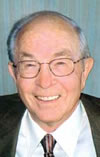 Harold Dougherty
Harold Dougherty
Harold “Hal” Dougherty, a long-time Berkeley Lab engineer, died last Sunday at the age of 84. He started at the Lab in the late 1950s and worked here for over 30 years. An artist by training, Dougherty built precision engineering models. His model of the 88-inch Cyclotron is on display in that building, and a portrait he painted of E.O. Lawrence hangs in the Building 50 lobby. Dougherty’s son Jim works as a mechanical technician in the Engineering Division.
The View Now Monthly
The View is moving to monthly publication due to budget constraints. Look for a new issue on the third Friday of each month. For daily news and information about the Lab and employee issues, see Today at Berkeley Lab, available via email and on the homepage at www.lbl.gov/today
Flea Market
- AUTOS & SUPPLIES
- 99 F-150 ext cab 4x4, 4-door, small V-8, 5 spd O/D manual trans tow package, cab-high shell, all power, a/c, tilt, cruise, CD-stereo, under 80 K mi, 1 owner, well maintained, all receipts avail, $10K, Tom, 430-1736
- MOTORCYCLES
- MOTORCYCLE HELMET, AGV full face, like new, size XS-6 7/8, $50, Stacey, X5106
- HOUSING
- ALBANY, furn room in shared apt off Solano, nr shops/rest/ pub trans, parking, pool, 528-3377
- BERKELEY, cottage studio in Berkeley hills, nr lab, priv patio in back, avail 10/15, Miller Ave. $1,050, Dan, 527-4917
- BERKELEY, 1 bdrm, 1 bth cottage, fenced yd, walk to N. Berkeley BART, water & garbage incl, free internet/DSL, w/d hookup, must be comfortable w/dogs, pets neg, avail 11/1, $900/mo, Arun, 843-3370
- BERKELEY, community of scient/staff/ grad students, Hearst Commons, nr UC/pub trans/BART, res parking, internet, studio townhouses w/decks, furn can be provided at no cost, hrdwd flrs, skylights, dw, disposals, ac, intercom, sec; $850, 848.5371 hearst.commons @jps.net for pictures or visit website: http://www.live-work.us/
- BERKELEY HILLS, fully furn rm w/ sep entry, full kitchen priv, w/d, quiet n’hood, next to bus stop, avail now, Arun, 524-3851
- BERKELEY HILLS, new fully furn studio w/priv kitchen/bthrm & entr, newly furn, TV/VCR/DVD player, all new kitchen appliances, shared w/d, Grizzly Peak Blvd, nr Lab, street parking, no smok/pets, min 6 mo, avail now, $850/mo incl util, Jiamin, 841-7556 or 486-6004
- EL CERRITO, 2 bdrm/1 bth house in quiet n’hood, newly remodeled w/new w/d, gas stove & dishwasher, lge windows, hrdwd flrs, central heating, fully furn, walk to BART and El Cerrito Plaza, avail from 12/1/05 to 5/31/06, $1,750/mo + util, Simon, 559-4674, simonalejandrino@hotmail.com
- NORTH BERKELEY, furn rm w/priv bth, sep entr, shared kitchen, common space, deck, in single family home, residential area, nr UCB/LBNL & pub trans, no smoking/pets, $500/mo, 528-9522
- NORTH BERKELEY, B & B, $675/mo, cozy furn room w/cable, great breakfast served daily, walk to LBL shuttle, avail immediately, 1 person only, Helen, 527-3252
- OAKLAND, crftsman bungalow in res n’hood, nr Mills College, 3 bdrm, 2 full bth avail 10/15, all new kitchen appliances, cabs & counters, hrdwd flrs, tenant pays water & PGE, 1 yr lease preferred, $2,000/mo, drive by: 5600 Fleming Ave, Valerie VDWysinger@ lbl.gov
- OAKLAND, Rockridge, 2 bdrm, 1 bth, sep din room, remodeled eat-in kitchen, fenced yard, off street pking, quiet n’hood, cl to shops/pub/trans & UC, avail 10/30 – 6/2006 nego, $2,000/mo, sec dep, refs, req, jpim@berkeley.edu, Jeanne, 843-317
- OAKLAND HILLS, 700 sq foot studio, above hwy 24, minutes from Clare-mont/Rockridge, Cal campus, priv entr, priv deck w/bay view, full kit & bth, fully carpeted, central heating/air, off street parking, all util incl, $1,000/mo 1st, last & dep, Stefano, X4726
- OAKLAND, lovely priv 2 bdrm cottage for rent, 887 61st St, between Market & MLK, katherinebettis@yahoo.com or 697-1860
- PIEDMONT, exc schools, 2 bedroom, 1 bth house, formal liv rm, din rm, & kit, laundry rm, storage shack, hrdwd flrs, garage, close to LBL/UCB, no smok-ing/pets, avail immediately, $2,400/mo, John, 268-1790, alpolo10@hotmail.com
- ROCKRIDGE, med size bdrm avail in lge upstairs 2 bdrm flat, nr UC/BART/LBNL shuttle, cl to Zachary’s Pizza, share with busy female physician and 1 cat, ideal for visiting scholar or professional, $750/mo, Judi, jmd520@ yahoo.com
- SAN LEANDRO, 2 bdrm/2 bth condo, located in a great neighborhood quiet & clean, close to shopping/Bart, new paint, new carpet & new kit floor, w/d in unit, 1 car port + 1 parking space, $1,200/mo + sec. dep, Bob, X6162, 357-2778
- MISC ITEMS FOR SALE
- DRYER, Roper electric 240 V, heavy duty, white, exc cond $85, Damian 638-1451
- DRYER, Maytag Neptune gas, model MDG5500, great cond, still has 2 yrs of extended warranty, $400, Bob, X2278 or (209) 620-7588
- JUICER, $15; airless paint sprayer $15; 4 head VCR $15; Roller blades size 10, $20; Ping-Pong paddles & net kit, $5, Duo, 528-3408
- PRINTER, Mac Stylewriter II Inkjet, w/ barely used black ink cartridge, powercord & cable, great cond, works w/Mac computers with parallel port, no USB, $25/bo, Mac keyboard & mouse, good cond, $10/bo, Melissa, 665-5572 - leave message
- SF OPERA TICKETS, Norma, Sat 10/29, 8 PM, 2nd row center balc pair, $124/pair, Paul, X5508, 526-3519
- FREE
- WINDSURFER, fair cond, some parts missing, pick up in San Francisco, Nat, X5308
- WANTED
- BRICKS, used free bricks, could use few hundred, but smaller quant also welcome, will pick up, Dianne, 528-9402
- VACATION RENTALS
- SO LAKE TAHOE, spacious chalet in Tyrol Area, close to Hvnly, fully furn, sleeps 8, deck, pool & spa in club house, close to casinos & other attractions, $150/day + $100 cleaning fee, Angela 724-9450
- KIHEI, MAUI, 1 bdrm condo, across street from best beach on Maui, Kamaole II, w/lifeguards, fully equipped, ocean & garden view from lanai - 4 nite min @ $90-100/nite, $525-595/wk 7 nites, Faye/John 697-2119 or eve 524-8734
- TAHOE KEYS, house, 3 bdrm, 2 1/2 bth, fenced yard, quiet sunny location, skiing nearby views of water & mountains, $195/night 2 night min, Bob, (925) 376-2211 or nbs@value.net
Flea Market Policy
Ads are accepted only from Berkeley Lab employees, retirees, and onsite DOE personnel. Only items of your own personal property may be offered for sale.
Submissions must include name, affiliation, extension, and home phone. Ads must be submitted in writing (e-mail: fleamarket@ lbl.gov, fax: X6641), or mailed/ delivered to Bldg. 65. Email address are included only in housing ads.
Ads run one issue only unless resubmitted, and are repeated only as space permits. The submission deadline for the November 18 issue is Thursday, November 10.
Berkeley Lab View
Published twice a month by the Communications Department for the employees and retirees of Berkeley Lab.
Reid Edwards, Public Affairs Department head
Ron Kolb, Communications Department head
EDITOR
Pamela Patterson, 486-4045,
pjpatterson@lbl.gov
STAFF WRITERS
Lyn Hunter, 486-4698
Dan Krotz, 486-4019
Paul Preuss, 486-6249
Lynn Yarris, 486-5375
CONTRIBUTING WRITERS
Jon Bashor, 486-5849
Allan Chen, 486-4210
David Gilbert, (925) 296-5643
Photography
Roy Kaltschmidt, 486-5731
Creative Services Office
FLEA MARKET
486-5771, fleamarket@lbl.gov
DESIGN
Caitlin Youngquist, 486-4020
Creative Services Office
Berkeley Lab
Communications Department
MS 65, One Cyclotron Road, Berkeley CA 94720
(510) 486-5771
Fax: (510) 486-6641
Berkeley Lab is managed by the University of California for the
U.S. Department of Energy.
Online Version
The full text and photographs of each edition of The View, as well as the Currents archive going back to 1994, are published online on the Berkeley Lab website under “Publications” in the A-Z Index. The site allows users to do searches of past articles.
